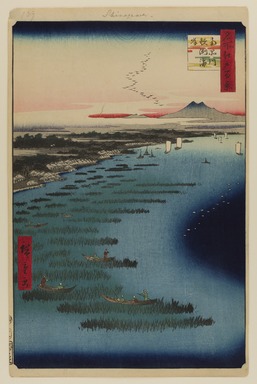
Artist:Utagawa Hiroshige
Medium: Woodblock print
Geograhical Locations:
Dates:2nd month of 1857
Dimensions: Sheet: 14 3/16 x 9 1/4 in. (36 x 23.5 cm) Image: 13 3/8 x 8 3/4 in. (34 x 22.2 cm)
Collections:
Exhibitions:
Accession Number: 30.1478.109
Image: 30.1478.109_PS20.jpg,
Catalogue Description: This view brings us to the Samezu shore, west of the Tokaido Highway, in the southern part of the Shinagawa settlement. A Zen temple is located in the upper left, by the black mass of trees, and Shinagawa Susaki (see print 83 of the series) extends out beyond the second white sail from the left. This coastal area was and continues to be known for the cultivation of nori, a kind of seaweed in which sushi is wrapped. Tree branches were placed in the shallow waters to promote the growth of the nori, and it was harvested at low tide from winter to spring, usually by women in small boats, as seen in this print. The nori cultivated in Edo Bay had the reputation of being the best in Japan. Samezu, or "shark sandbar," derives its name from the founding of Kaianji Temple. It has been said that in 1251 a shark washed up on the shore here with an image of Kannon in its belly. It was thought to be a good omen, and a temple of the Zen sect was dedicated to provide for the Kannon. The place name survives as a station on the Keihin Kyuko Line, but the entire stretch of coast has since been filled in.